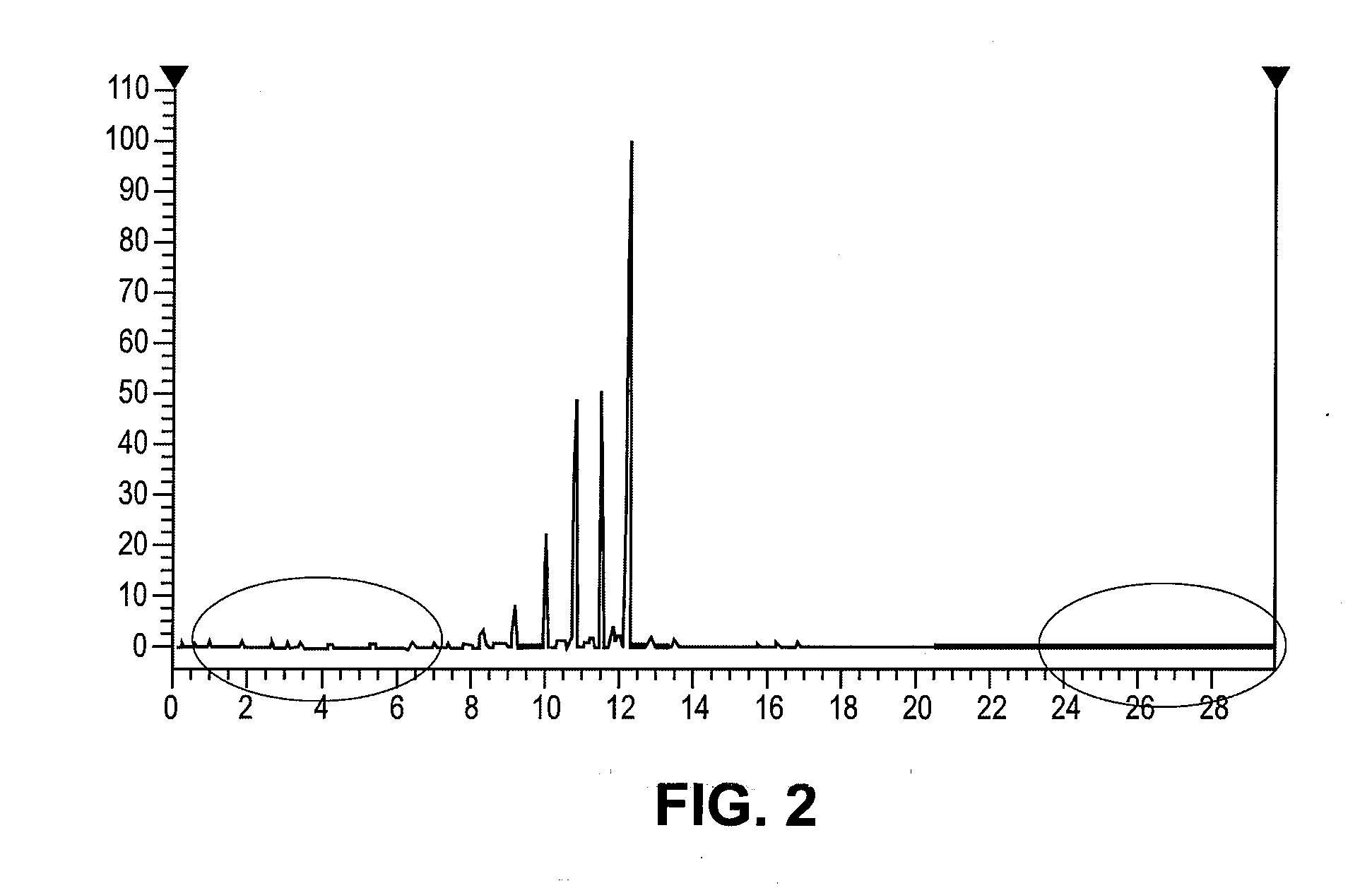Process for co-producing jet fuel and LPG from renewable sources
a technology of jet fuel and renewable sources, which is applied in the direction of fuels, gaseous fuels, hydrocarbon oil treatment products, etc., can solve the problems of additive products that are characterized as not always acceptable for commercial use, methods that are limited, and additive products that are characterized as poor at low temperatures, so as to improve cold flow properties
- Summary
- Abstract
- Description
- Claims
- Application Information
AI Technical Summary
Benefits of technology
Problems solved by technology
Method used
Image
Examples
example 1
Process of Making a Jet Fuel from Renewable Sources
[0031]The present example demonstrates how a jet fuel was made from a renewable feedstock. A 100 cc isothermal tubular reactor was filled with 80 cc of Criterion 424 Ni—Mo catalyst and +70-100 mesh glass beads. The catalyst was sulfided with dimethyl disulfide at two hold temperatures: 6 hours at 400° F. and 12 hrs at 650° F. Hydrogen sulfide break-through was confirmed before the temperature was raised from 400° F. to 650° F. at 50° F. / hr. After sulfiding, the reactor was cooled to 400° F.
[0032]Next a triglyceride / fatty acid feed was introduced to the isothermal reactor. The reactor was slowly heated to 650° F. to achieve full conversion of the triglyceride / fatty acid feed to n-paraffins. The reactor temperature was further increased to 700° F. to maintain good catalyst activity at 80 cc / hr feed rate (1 LHSV).
[0033]The total liquid hydrocarbon (TLH) from the hydrotreater was then hydroisomerized to jet fuel using the conditions sum...
example 2
[0034]The hydrotreated effluent was analyzed using a gas chromatogram. In particular, the total liquid hydrocarbon (TLH) from the hydrotreater reaction of Example 1 was analyzed to confirm triglyceride conversion, and quantify cracking to light ends.
[0035]The gas chromatogram utilized the following materials:
[0036]Materials:
[0037]Analytical Balance, capability to 0.1 mg
[0038]Carbon Disulfide, High Purity
[0039]Custom Alkane Standard—Restek Cat #54521
[0040]Pasteur Pipette with bulb
[0041]HP 5860 Gas Chromatograph—FID
[0042]GC Column, Restek—Rtx—1 MS, Cat #11624
[0043]Helium Gas—Alpha Gas
[0044]Hydrogen Gas—Alpha Gas
[0045]Zero Air Gas—Alpha Gas
[0046]Sharpie
[0047]GC Vials and Caps
[0048]The gas chromatogram was operated under the following conditions:
[0049]Runtime 82 minutes
[0050]Injection Volume 1-pL
[0051]Inlet Temperature 320° C.
[0052]Detector Temperature 350°
[0053]Oven:[0054]Initial Temperature 35° C.[0055]Rate (° C. / min) 5.00[0056]Equilibrate Time 0.20 min[0057]Final Temperature 320° C.[...
example 3
Jet Fuel from Renewable Sources
[0059]The resultant jet fuel and the isoparaffinic product from Example 1 was analyzed and compared to similar products. The feedstock jet fuel was found to have a cloud point of −53° C.
[0060]The composition of the isoparaffinic product was analyzed via Gas Chromatograph and is summarized in Table 3. A key property to observe is iso / normal ratio. The procedure employed to determine iso / normal ratio is shown below. As indicated by Table 3 data, the hydroisomerizer product may be fractionated to the desired jet fuel boiling range. Such separation was performed using standard lab distillation apparatus. The comparable properties of Fischer-Tropsch IPK jet fuel distillate are summarized in Table 5. As observed from Table 4, the renewable jet fuel of this invention met or exceeded all key specifications of commercial jet fuel.
TABLE 3Carbon Number Distribution and Iso / NormalRatio of Hydroisomerizer ProductIso / NormalNormalIsomerNormalRatio byMass %GroupMWMass...
PUM
 Login to View More
Login to View More Abstract
Description
Claims
Application Information
 Login to View More
Login to View More - R&D
- Intellectual Property
- Life Sciences
- Materials
- Tech Scout
- Unparalleled Data Quality
- Higher Quality Content
- 60% Fewer Hallucinations
Browse by: Latest US Patents, China's latest patents, Technical Efficacy Thesaurus, Application Domain, Technology Topic, Popular Technical Reports.
© 2025 PatSnap. All rights reserved.Legal|Privacy policy|Modern Slavery Act Transparency Statement|Sitemap|About US| Contact US: help@patsnap.com



